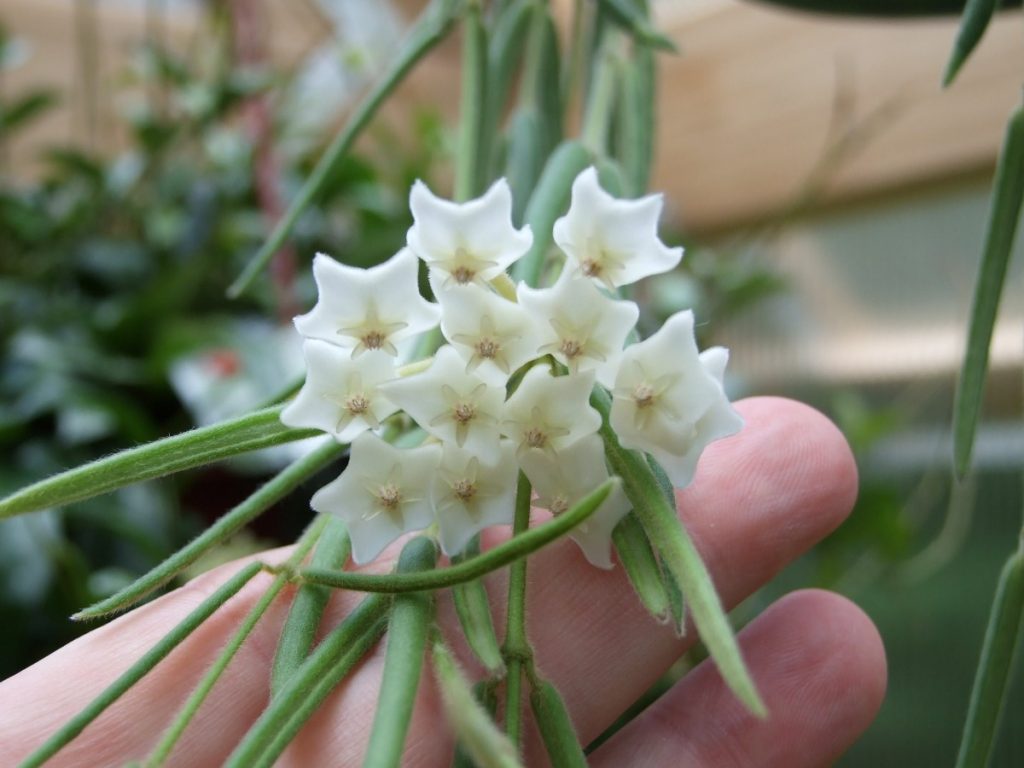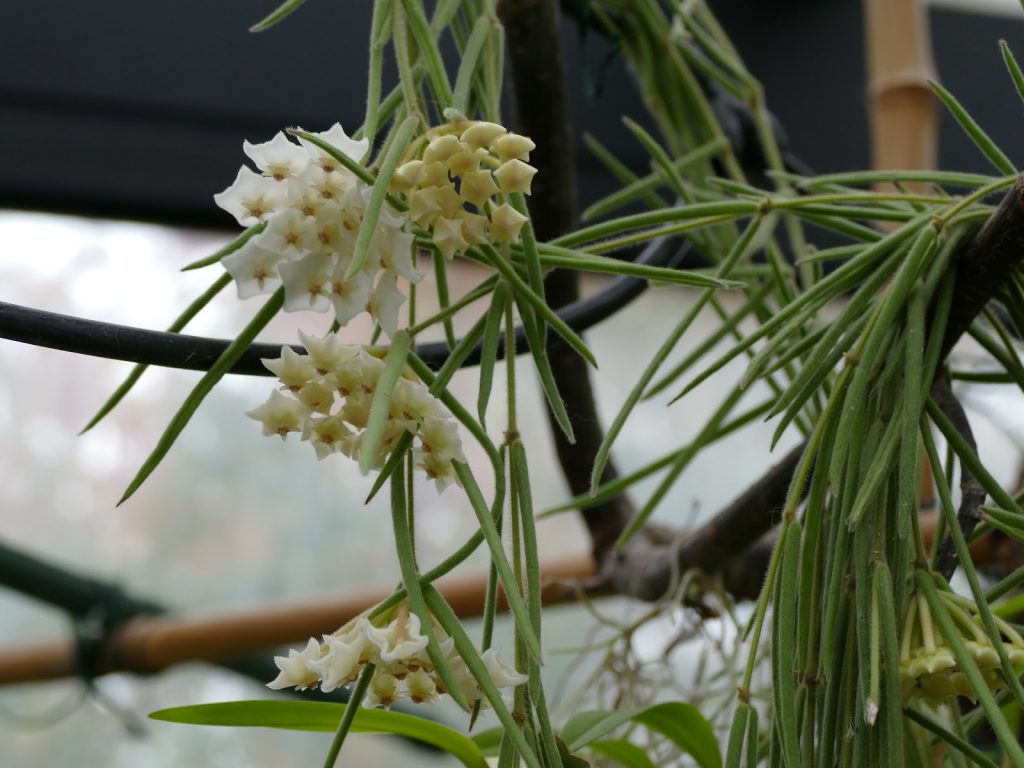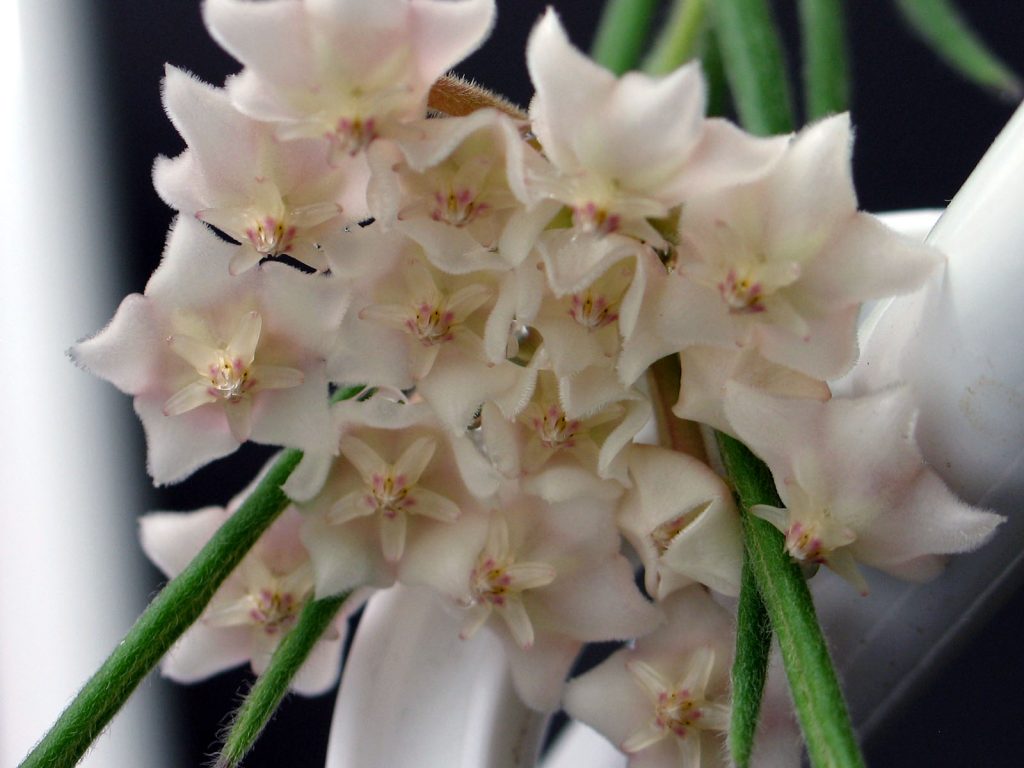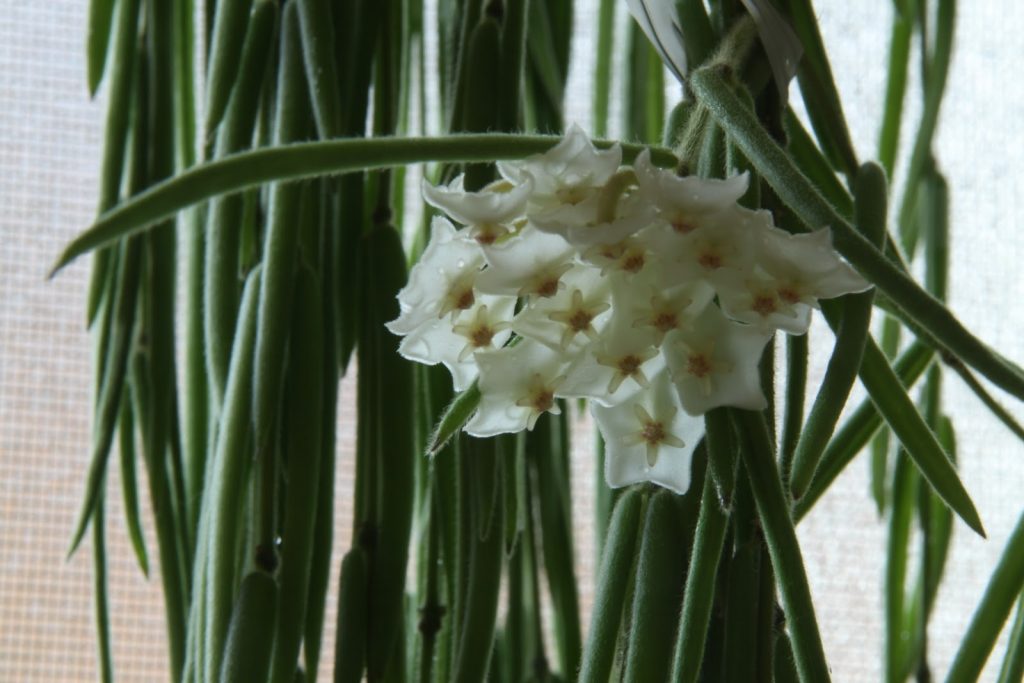Hoya Linearis - growing an exotic beauty
Hoya Linearis is a beautiful ampelous plant, even with minimal care, it is able to delight with graceful exotic flowering. It got its name in honor of Thomas Hoya, a former gardener at the ducal court in England. In the wild, it is found in the mountainous regions of Nepal, China, Burma, India.

Hoya linearis flowers
Description of the plant
Hoya Linearis grows in the form of a liana, its stems can reach 6 m. Along the entire length of the vegetative processes, there are narrow and slightly elongated linear leaves that visually resemble coniferous needles.
The sheet plates are not more than 2 mm wide, have a lowered shape with inwardly curved edges. The color of the foliage is gray-green, the young shoots are almost white. The distance between the nodes does not exceed 5 cm.
Flowers are formed at the ends of branches, are 1 cm in diameter, collected in inflorescences from 10 to 20 pieces. Painted in cream color with a slight yellowish tint. The aroma is pronounced, with hints of vanilla or lily. The flowering period is July-October.
The root system is superficial, and therefore the plant grows in breadth, and not in depth.
Purchase and adaptation
After the acquisition, the exotic liana is isolated. For a 2 week period, it is necessary to check it for possible diseases and the vital activity of harmful insects.

Hoya linearis
If the hoya is healthy, it is allowed to move it to a room with other green pets.
Landing rules
Pot selection
For young plants, pots with a diameter of 9 cm are used, the volume of which is further increased by 2 cm.
It is better to choose a container wide, with low sides, which is due to the characteristics of the root system.
Selection of soil and location
The best option for the location of Hoya at home is window sills with an exit to the south-west or southeast, on which she will be provided with the necessary amount of light without much risk of getting sunburn.
Hoya does not set any requirements for soil. In nature, she feels quite comfortable even on poor soils and is able to grow in mountain crevasses.
For the most active development at home, use universal soil mixtures or make them up independently.
In the latter case, mix:
- leafy ground (3 parts);
- river sand (1 part);
- turf (2 parts);
- humus (2 parts).
Additionally, the container is equipped with a drainage layer, which contributes to a higher moisture permeability of the soil and prevents liquid stagnation.
The necessary conditions
It is not difficult to create favorable conditions for the active development of Hoya. Despite the exoticism, kulturna feels quite comfortable in city apartments.

Hoya linearis photo
Humidity
In extreme heat, in summer and during the heating season, the plant needs daily spraying.Enough adult specimens are allowed to occasionally be placed under a shower with a weak water pressure.
Temperature regime
Like any plant from the tropics, hoya does not tolerate low temperatures, which negatively affect the condition of the root system. Optimum performance in summer is 22-25 ° C.
The hotter and at the same time dry microclimate leads to the weakening of the leaf plates and their further death. In the dormant stage, which Linearis enters into in winter, the temperature is reduced to about 15 ° C.
Illumination
The plant prefers to grow in good lighting conditions.
The optimal daylight hours are 14-16 hours. If it takes longer, there is a possibility of burns on the surface of delicate leaves.
Location in partial shade tolerates without any problems, but blooms less abundantly.
Care
The flower does not need close attention, so even a novice florist can provide it with proper care. The main thing is to carefully study the requirements of culture and comply with them without deviating from the norm.

Hoya linearis home care
Watering
Hoya prefers abundant watering, especially during the growing season. On average, soil moistening during the period of active growth is done every 7 days, in winter the interval between procedures is increased to 2 weeks.
At the same time, it is necessary to ensure that the earthy clod does not dry out completely - in the flowering phase this can lead to the loss of buds. Moisture stagnation should also be avoided; excessive moisture in the substrate is the cause of root decay.
Top dressing
In winter, dressings are completely abandoned. During the growing season, mineral complexes are added to the water for irrigation, reducing the concentration recommended on the package by 3 times. The average frequency of fertilization is once every 2-3 weeks.
Transfer
In one place, a culture is capable of growing for a fairly long period of several years.
The transplant capacity is chosen only 2 cm larger than the previous one in diameter. A larger container will lead to a slowdown in development - the exotic will direct all its efforts to master the contents of the pot.
Pruning
Does not need regular pruning. Moderate cutting of vegetative shoots is allowed so that the plant grows in breadth. It is preferable to cut off older segments, young ones are extremely sensitive to damage and can dry out.
Reproduction methods
Seeds
It is impossible to get seed on your own at home. It is better to purchase it in a specialized store, while you should carefully check the expiration dates. Old seeds are poorly germinated.

Hoya linearis care
From the moment of planting the seeds to the appearance of the first true leaves, it will take about 3 months. At this time, the soil is regularly moistened, avoiding drying out. Additionally, they maintain a stable temperature and dim lighting.
Cuttings
The simplest and most productive way of breeding Hoya Linearis. For planting, the processes of adult vines are used, the cuttings from which are cut so that 2-3 nodes and several leaf blades remain on them.
The shoots are trimmed with a well-sharpened and sterile instrument, then placed in a container with water wrapped in foil.
After a couple of weeks, the roots appear, and the plant is ready to be transported to the substrate.
Layers
Reproduction principle:
- An incision is carefully made on the shoot of an adult liana.
- Wet sphagnum is placed on the wound, wrapped in polyethylene.
- After the formation of roots, the layers are completely cut off and planted in the ground.
Growing problems
Diseases
Hoya varieties Linearis are quite resistant to pests and diseases. Basically, such situations arise due to improper care.
| Problem | Cause |
| Leaves fall | Excessive watering (often observed during the cold season) |
| Leaf plates turned yellow, cracks appeared on the stems | Sharp fluctuations in temperature |
| Discoloration of leaves and buds | Top dressing in hot weather |
| Lack of flowering | Deviations from the norms of the microclimate of the room / deficiency of nutrients |
| Decay of the root system | Stagnant moisture / lack of drainage layer |
| Slow growth | Lack of nitrogen |
| Whitish coating on the surface | Fungal infection (the plant is rinsed in the shower, treated with chemicals) |
| Brown spots | Pest infestation |
Pests
| Insect | Symptoms | Prophylaxis | Treatment |
| Shield | Small bumps and spots on the surface. Shoots and leaves fall off, buds do not open. The growth of the flower stops. | Injured and rotten segments are promptly removed. Regularly watered with a solution of potassium permanganate. Before planting, the soil mixture is calcined in the oven. | They are treated with soap or wood ash-based solution. Chemical compositions are used: Mospilan, Aktellik, Inta-Vir, Aktara, Bankol. |
| Mealybug | Suspension of growth processes, cotton-like bloom, deformation of young shoots, leaf fall. | Carry out preventive treatment with soap / garlic solution, Regularly ventilate the room, maintain air humidity at the required level. | Place the vine under a warm shower, wipe it with a solution based on laundry soap. Sprayed with Phosphamide, Nural-L, Aktara or Rogor. |
| Root nematode | Retarded development, leaves and shoots near the base wrinkle, bald spots appear. | Fallen and yellowed leaves are removed in a timely manner, adhere to the recommended irrigation system, trying not to overmoisten the substrate. | The soil is fumigated with the following preparations: Dimethoat, Rogor, Vidat, Nemaphos, BI-58. |

